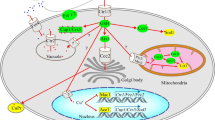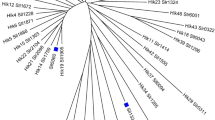Summary
The PAR1/SNQ3 gene of S. cerevisiae, which increases resistance to iron chelators in multi-copy transformants, is identical to the YAP1 gene, a yeast activator protein isolated as a functional homologue of the human c-jun oncogene by binding specifically to the AP-1 consensus box. The observed H2O2-sensitivity of par1 mutants has been attributed to an increased sensitivity to reduced oxygen intermediates. Accordingly, par1 mutants did not survive an elevated oxygen pressure and were very sensitive to menadione and methylviologene, two chemicals enhancing the deleterious effects of oxygen. The specific activities of enzymes involved in oxygen detoxification, such as superoxide dismutase, glucose 6-phosphate dehydrogenase and glutathione reductase, were decreased in par1 mutants and increased after PAR1 over-expression. As in the case of oxygen detoxification enzymes, the cellular levels of glutathione were similarly affected. These observations indicate that PAR1/YAP1/SNQ3 is involved in the gene regulation of certain oxygen detoxification enzymes. The finding that H2O2 promotes DNA-binding of human c-jun is consistent with a similar function for PAR1/YAP1/SNQ3 and c-jun in cellular metabolism.
Similar content being viewed by others
References
Angel P, Imagewa M, Chiu R, Stein B, Imbra RJ, Rahmsdorf HJ, Jonat C, Herrlich P, Karin M (1987) Cell 49:729–739
Angel P, Allegretto EA, Okino ST, Hattori K, Boyle WJ, Hunter T, Karin M (1988) Nature 332:166–171
Belazzi T, Wagner A, Wieser R, Schanz M, Adam G, Hartig A, Ruis H (1991) EMBO J 10:585–592
Bergmayer HU (1974) Methoden der enzymatischen Analyse 3rd edn. Verlag Chemie, Weinheim, pp. 459–461, 494–495, 674–675
Bermingham-McDonogh O, Gralla EB, Selverstone Valentine J (1988) Proc Natl Acad Sci USA 85:4789–4793
Bilinski T, Krawiec Z, Litwinska J, Blaszczynski M (1988) Oxy-radicals in molecular biology and pathology. In: Cerutti PA, Fridsrich J, McCord JM (eds.) UCCLA Symposium on Molecular and Cellular Biology. Atlan R Liss, New York, pp 109–125
Chan E, Weiss B (1987) Proc Natl Acad Sci USA 84:3189–3193
Chiu R, Boyle WJ, Meek J, Smeal T, Hunter T, Karin M (1988) Cell 54:541–552
Ciriacy M (1977) Mol Gen Genet 176:427–431
Devary Y, Gottlieb RA, Lau LF, Karin M (1991) Molec Cell Biol 11:2804–2811
Fridovich I (1989) J Biol Chem 264:7761–7764
Garcia J, Harrich D, Pearson L, Nutsuyasu R, Gaynor R (1988) EMBO J 7:3143–3147
Greenberg JT, Demple B (1989) J Bacteriol 171:3933–3939
Gregory EM, Fridovich I (1973) J Bacteriol 114:543–548
Halliwell B, Gutteridge JMC (1986) Trends Biochem Sci 11:372–375
Halliwell B, Gutteridge MC (1990) Methods Enzymol 186:1–89
Hansen H, Roggenkamp R (1989) Eur J Biochem 184:173–179
Harshman KD, Moye-Rowley WS, Parker CS (1988) Cell 53:321–330
Hassan HM, Fridovich I (1979) J Biol Chem 254:10864–10852
Hertle K, Haase E, Brendel M (1991) Curr Genet 19:429–433
Hope I, Struhl K (1985) Cell 43:177–188
Imlay JA, Linn S (1988) Science 240:1302–1309
Landschulz WH, Johnson PF, McKnight SL (1988) Science 240:1759–1764
Lee W, Haslinger A, Karin M, Tjian R (1987a) Nature 325:368–372
Lee W, Mitchell P, Tjian R (1987b) Cell 49:741–752
Levin JD, Johnson AW, Demple B (1988) J Biol Chem 263:8066–8071
Linda (1989) Bacteriol 171:868–873
Maitra PK, Lobo Z (1971) J Biol Chem 246:475–488
Miskin R, Ben-Ishay R (1981) Proc Natl Acad Sci USA 78:6236–6240
Moody C, Hassan HM (1982) Proc Natl Acad Sci USA 79:2855–2859
Moye-Rowley WS, Harshman KD, Parker CS (1989) Genes Develop 3:283–292
Niederhoffer EC, Naranjo CM, Bradley KL, Fee JA (1990) J Bacteriol 172:1930–1938
Nogae I, Johnston M (1990) Gene 96:161–169
Oyanagui Y (1984) Anal Biochem 142:290–296
Ryder K, Lau LF, Nathans D (1988) Proc Natl Acad Sci USA 85:1487–1491
Schnell N, Entian K-D (1991) Eur J Biochem 200:487–493
Schreck R, Rieber P, Baeuerle PA (1991) EMBO J 10:2247–2258
Storz G, Tartaglia LA, Farr SB, Ames BN (1990) Trends Genet 6:363–368
Tardat B, Touati D (1991) Mol Microbiol 5:455–465
Tietze F (1969) Anal Biochem 27:502–506
Tsaneva IR, Weiss B (1990) J Bacteriol 172:4197–4205
Turrens JF, Boveris A (1980) Biochem J 191:421–427
Weisshaar B, Armstrong GA, Block A, da Costa e Silva O, Hahlbrock K (1991) EMBO J 10:1777–1786
Westerbeek-Marres CAM, Moore MM, Autor AP (1988) Eur J Biochem 174:611–620
Zamenhoff S (1957) Methods Enzymol 3:696–704
Author information
Authors and Affiliations
Additional information
Communicated by F. K. Zimmermann
Dedicated to Professor Dr. R. W. Kaplan on the occasion of his 80th birthday
Rights and permissions
About this article
Cite this article
Schnell, N., Krems, B. & Entian, KD. The PAR1 (YAP1/SNQ3) gene of Saccharomyces cerevisiae, ac-jun homologue, is involved in oxygen metabolism. Curr Genet 21, 269–273 (1992). https://doi.org/10.1007/BF00351681
Received:
Issue Date:
DOI: https://doi.org/10.1007/BF00351681




